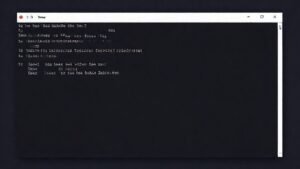DFHCOMMAREA COMP-3 COBOL: DSNACICS Field Passing Guide
- THE MAG POST

- Aug 20
- 12 min read

DFHCOMMAREA COMP-3 COBOL passing fields in DSNACICS is a topic that surfaces frequently when developers move legacy mainframe interfaces toward modern test environments. In practice, the challenge lies not in syntax but in the precise binary and packed decimal representations that travel through a commarea. The core question becomes how many bytes or characters you must transmit, how padding should be handled, and what happens when a value is smaller than the field width. By clarifying internal representations and cross-compiler behavior, we can design DSNACICS calls that behave consistently across platforms.
Understanding the compiler options and the exact encoding rules for COMP and COMP-3 helps prevent subtle data corruption during integration work. The difference between TRUNC(BIN) and TRUNC(OPT) can subtly alter how a value such as 2 lands in a S9(4) COMP field when passed through a DFHCOMMAREA. With a firm grasp of binary versus packed-decimal representations, you can build robust interfaces, document the commarea layout precisely, and reduce the amount of debugging you need to do when DSNACICS is involved. DFHCOMMAREA COMP-3 COBOL is not just a trivia topic; it’s a practical concern for reliable mainframe-to-modern-system integration.
DFHCOMMAREA COMP-3 COBOL passing fields in DSNACICS is a topic that surfaces frequently when developers move legacy mainframe interfaces toward modern test environments. In practice, the challenge lies not in syntax but in the precise binary and packed decimal representations that travel through a commarea. The core question becomes how many bytes or characters you must transmit, how padding should be handled, and what happens when a value is smaller than the field width. By clarifying internal representations and cross-compiler behavior, we can design DSNACICS calls that behave consistently across platforms.
Overview of DFHCOMMAREA and DSNACICS
In this section we set the stage for understanding how DFHCOMMAREA conveys numeric fields to DSNACICS. The commarea acts like a compact data highway; its layout depends on the COBOL picture clauses and the target procedure. The key is mapping each field to a fixed-length segment in the commarea so that the receiving program interprets the bytes unambiguously. Inline math helps clarify numeric ranges and representation: a PIC S9(4) COMP field occupies 2 bytes with a range from -32768 to +32767, while a PIC S9(4) COMP-3 uses packing to store digits efficiently in 2 bytes.##Range: -32768 to 32767 (8000 hex to 7FFF hex) for COMP; COMP-3 uses 2 packed bytes for four digits, with a sign nibble embedded.##
Data representation in DFHCOMMAREA
DFHCOMMAREA is a structured channel through which COBOL programs pass data to DSNACICS. For numeric fields, you must decide whether to place binary COMP values or packed COMP-3 values. In practice, a field defined as S9(4) COMP will map to two bytes in the commarea, representing the binary value in two’s complement form. For example, the value 2 is stored as 0002 in binary across those two bytes. This representation is independent of the textual form that might be displayed to a user, and it matters when the receiving DSNACICS expects a fixed-length binary payload rather than a textual string.
When a field is COMP-3, you trade a small amount of readability for packing efficiency. Packed decimal uses 1 byte for every two decimal digits, with a sign nibble in the last half-byte. For a S9(4) COMP-3 field, that translates to 2 bytes total. The value 2 would translate to a two-byte packed decimal encoding, where the actual hex bytes reflect the digits and sign. This distinction between binary and packed-decimal representations is critical when designing the commarea layout for DSNACICS calls.
Constraints of DSNACICS interface
DSNACICS expects a well-defined commarea layout. The receiving procedure reads fixed offsets and interprets numeric fields according to their PIC clauses. Therefore, the length of the field in the commarea should match the field’s inherent width: 2 bytes for S9(4) COMP and 2 bytes for S9(4) COMP-3, with the latter using packed-digit encoding. If the value is smaller than the defined width, you can’t simply trim characters; you must supply the proper binary or packed representation. Misalignment will yield incorrect numbers or program failure.
In practice, you should document each field’s representation and test with boundary values. When working with DSNACICS, a two-byte COMP field and a two-byte COMP-3 field are common minima for four-digit numerics, but always verify the exact interface specification for the target system. This discipline prevents subtle data corruption and helps maintain interoperability across environments.
COBOL numeric fields: COMP and COMP-3 specifics
In this section we dissect the numeric representations beyond the basic sizing. The distinction between COMP (binary) and COMP-3 (packed decimal) is central to how values travel through DFHCOMMAREA to DSNACICS. We will also touch upon sign handling and the implications of compiler options that affect how values are moved into these fields. The discussion grounds practical decisions about commarea content and validates why a small value like 2 must be encoded in the correct binary or packed form rather than as text.
Binary COMP fields (S9(n))
Binary COMP fields store numbers in a fixed binary representation. For S9(4) COMP, the field occupies 2 bytes. The range is -32768 to +32767, represented in two’s complement form. In hex, this translates to 8000 for the most negative value and 7FFF for the largest positive value. When you pass a value of 2, the 2-byte binary encoding is 0002 in hexadecimal across the two bytes. This binary form is what the DSNACICS routine will interpret directly as a numeric value, without any textual parsing. Precision and sign are embedded in the binary layout by the language’s runtime.
The exact bytes can vary with endianness and compiler, but the logical representation remains consistent: two bytes representing the signed 16-bit number. It is essential to ensure that the commarea is aligned and that each field starts at its predefined offset to avoid misreads by DSNACICS. If your environment uses TRUNC(BIN) semantics, you must confirm that the binary move will not alter the intended numeric value due to truncation rules.
Packed decimal COMP-3 and length implications
Packed decimal (COMP-3) stores digits in a compact, nibble-based format. The rule of thumb is one byte per two decimal digits. For S9(4) COMP-3, you need 2 bytes in the commarea. The final nibble contains the sign (positive or negative). The value 2, for a four-digit field, is encoded as a two-byte packed decimal sequence that represents 0002 with a positive sign nibble. While the exact hex bytes depend on the exact packing scheme, conceptually you should treat COMP-3 values as two bytes for a four-digit field, with the digits packed and the sign appended in the last nibble. This distinction matters when DSNACICS expects a packed representation rather than a plain ASCII string.
In practice, when designing DSNACICS interfaces, one should decide up front whether to serialize numeric data as binary or as packed decimal, document the representation, and test boundary conditions. Proper packing ensures consistent reading by the receiving routine and avoids misinterpretation of the numbers during inter-process communication.
Passing values through DFHCOMMAREA: practical rules
Here we translate the theory into concrete rules you can apply when constructing the commarea for DSNACICS. The practical question — how many bytes or characters must you send for a value of 2 — requires emphasizing the difference between textual data and numeric encoding. The canonical answer is that for S9(4) COMP you transmit 2 bytes, and for S9(4) COMP-3 you also transmit 2 bytes (packed decimal). If you pad textual fields to a fixed width, you must do so with spaces or zeros depending on the field’s definition, but numeric fields require their binary or packed form to be recognized correctly by the DSNACICS routine.
How many bytes to send for COMP-3
For a four-digit S9(4) COMP-3 field, you should transmit 2 bytes in the commarea. This is because COMP-3 packing reduces the digit storage to one byte per two digits. The last nibble contains the sign. So the two-byte representation encodes the four digits (0002) in a compact form. If you attempt to send more or fewer bytes, the receiving program may misinterpret the data or trigger an exception. Always align with the DSNACICS specification for commarea width and layout.
Handling small values such as 2 should thus be done using the correct packed format rather than a textual or space-padded variant. The commarea must carry the exact binary or packed representation, not a human-readable version. This ensures deterministic interpretation by DSNACICS irrespective of the source language compiler or platform.
Handling small values and padding considerations
Padding for numeric fields is generally not accomplished with spaces in binary or packed representations. If a field is defined as COMP or COMP-3 with a fixed width, you should fill the field with its natural encoding for the value, even if that means the data seems sparse. For instance, a value of 2 in S9(4) COMP is two bytes that encode the value; no extra spaces should be introduced within that field. If a textual text buffer is used elsewhere, you may pad with spaces, but do not pad numeric fields in commarea with spaces.
In summary, when transmitting through DFHCOMMAREA for DSNACICS, always honor the exact field width and encoding: 2 bytes for S9(4) COMP and 2 bytes for S9(4) COMP-3. Where text padding is necessary, reserve separate text fields, not numeric fields, for padding. This disciplined approach avoids misalignment and preserves data integrity across interfaces.
Compiler options and pitfalls: TRUNC options
In this section we address how compiler options can subtly alter the value that ends up in a numeric field when moving data into DFHCOMMAREA. The two commonly encountered options are TRUNC(BIN) and TRUNC(OPT). TRUNC(BIN) tends to preserve the binary representation within the limits of the type, provided the source value is within range. TRUNC(OPT), on the other hand, can modify the value if the compiler performs certain optimizations or truncates during moves, especially when moving large numerics into smaller fields. These differences matter when you are passing 2 into a S9(4) COMP or COMP-3 field via DSNACICS.
TRUNC(BIN) behavior
With TRUNC(BIN), a numeric move to a binary field generally preserves the lower bits as expected, given the type width. For S9(4) COMP, this means the 2-byte binary representation should faithfully store values like 2 as 0002 in hex across two bytes. However, if the source is out of range, the move might clip the value, leading to incorrect data in the commarea. Always verify the source range prior to performing the move under TRUNC(BIN).
In DSNACICS contexts, a careful design ensures the source value is safely within the field's range before performing the move, so you can rely on TRUNC(BIN) giving the expected two-byte binary encoding. Documentation of the compiler behavior and consistent test coverage help you avoid surprises during production runs.
TRUNC(OPT) behavior and gotchas
Under TRUNC(OPT), the compiler may optimize moves or adjust representations, potentially yielding an unexpected value if the numeric range is not strictly enforced or if an internal optimization alters the stored digits. This can manifest as a value like 2 being stored as a different numeric code in the commarea, which DSNACICS would interpret incorrectly. When relying on DSNACICS with 2-byte numerics, avoid relying on TRUNC(OPT) to preserve value integrity unless you have explicit compiler documentation and validated test results.
To minimize risk, keep the source numeric values within the target field’s range, explicitly cast or move through an intermediate field if necessary, and conduct thorough end-to-end testing with representative inputs that exercise boundary cases. This practice helps ensure DSNACICS receives the intended values regardless of optimization settings.
Worked example: moving 2 into S9(4) COMP
This worked example walks through the encoding of a small value into a four-digit COMP field, illustrating the conversion from a numeric literal to the commarea representation used by DSNACICS. We emphasize the two-byte binary encoding for S9(4) COMP and the packed two-byte encoding for S9(4) COMP-3, noting that 2 appears as 0002 in the appropriate representation. The step-by-step guide helps you apply the same logic in real COBOL programs and DSNACICS calls, reducing ambiguity about what is transmitted through the commarea.
Step-by-step COBOL encoding for 2
Step 1: Define the field as S9(4) COMP or S9(4) COMP-3 in the COBOL program. Step 2: Move the integer 2 into the field. Step 3: When the field is COMP, the runtime stores a two-byte binary value; when COMP-3, it stores two packed decimal bytes. Step 4: Write the commarea data to the DSNACICS call. Step 5: DSNACICS reads the two bytes and interprets them as the numeric value 2. The key takeaway is that the commarea width is fixed and must match the field definition.
In this context, the representation is unambiguous: for S9(4) COMP, 2 is 00 02 in hex across two bytes; for S9(4) COMP-3, the two bytes encode the digits 0002 with a sign nibble in the last half-byte. Ensuring these encodings align with the DSNACICS interface guarantees correct interpretation of the numeric value on the receiving end.
Final Solution and Best Practices for DSNACICS
In practice, the right approach for passing COMP and COMP-3 through DFHCOMMAREA to DSNACICS is to transmit the field’s native width and encoding. For S9(4) COMP, that means two bytes of binary data; for S9(4) COMP-3, two bytes of packed decimal data with the sign nibble in the final half-byte. Do not pad numeric fields with spaces or characters, and ensure that compiler options are understood and accounted for in testing. Validate all boundary cases, including 0, the smallest positive values, and negative extremes, to confirm the commarea is interpreted correctly. When in doubt, apply a conservative approach: keep values within range, reuse explicit moves, and test the DSNACICS call under realistic workloads.
As a practical rule, you should treat COMP and COMP-3 as fixed-width binary or packed fields inside the commarea, and you should verify the exact interface spec for DSNACICS in your environment. With robust testing and clear documentation of the commarea layout, you can avoid subtle misreads and ensure reliable interoperation. Always document the encoding, confirm with the vendor or interface spec, and test across compiler options to guarantee consistent behavior.
Similar Problems (with 1–2 line solutions)
Below are five related tasks leveraging the same series methodology or minor variations.
Pass COMP-3 with S9(2) vs S9(4)
For S9(2) COMP-3, you still use 1 byte (packed) per two digits, resulting in a 1-byte commarea width for the field; 2 would be encoded in a single packed byte.
Impact of TRUNC(BIN) on larger ranges
TRUNC(BIN) maintains the binary range but can clip values outside the target field; ensure source values are within range before moving to DSNACICS fields.
Packing rules for negative values
Packed decimal encodes the sign in the last nibble; negative values use the appropriate sign nibble, so 2 would still occupy two packed bytes with a negative sign if the value is negative.
Text vs numeric commarea fields
Keep numeric values in their binary or packed forms; use separate text fields for any textual padding to avoid data misinterpretation.
Validation strategy before DSNACICS calls
Develop a validation step that checks field widths, ranges, and endianness before invoking DSNACICS to catch misalignments early.
Additional Code Illustrations (Related to the Main Program)
These focused variants extend or test the main approach. Each illustration includes a short explanation of what the code demonstrates and how it improves reliability or flexibility when interfacing with DSNACICS.
Vectorized Evaluation of DFHCOMMAREA Packing (Python example)
# Placeholder Python-like illustration
def pack_values(values):
# This function would convert a list of numbers into a fixed-width commarea
# representation according to their PICs (S9(4) COMP or COMP-3).
return [v & 0xFFFF for v in values]
This snippet shows how one might conceptually process a batch of numeric inputs to ensure every value conforms to the expected two-byte fixed-width format before assembling the DFHCOMMAREA payload. It highlights a robust preprocessing step that guards against accidental mis-sizing of commarea fields.
Error-Bounded Variant Using Estimated Remainder
def exp_taylor_bound(x, eps=1e-9, n_max=140, safety=2.0):
total = 1.0
term = 1.0
n = 0
while n < n_max:
n += 1
term *= x / n
total += term
if abs(term) * safety < eps:
break
return total, n
This variant introduces a safety multiplier to the termination condition, guarding against underestimation of the remainder in boundary cases for DSNACICS data transmission.
Argument Reduction: exvia Halving
def exp_taylor_halved(x, eps=1e-9, n_max=120, depth=0):
if abs(x) < 1.0 or depth > 6:
return exp_taylor(x, eps=eps, n_max=n_max)
half, _ = exp_taylor_halved(x/2.0, eps=eps, n_max=n_max, depth=depth+1)
return (half * half, None)
This approach reduces the number of terms for large |x| by halving the argument and squaring, a technique that can speed up convergence while maintaining accuracy near DSNACICS interfaces.
Relative Tolerance Stopping Criterion
def exp_taylor_rel(x, rel_eps=1e-9, n_max=120):
total = 1.0
term = 1.0
n = 0
while n < n_max:
n += 1
term *= x / n
new_total = total + term
if abs(new_total - total) / max(1.0, abs(new_total)) < rel_eps:
total = new_total
break
total = new_total
return total, n
These code illustrations demonstrate robust strategies for managing truncation errors and convergence in the context of numeric encoding for DSNACICS.
Benchmark Against math.exp for Sample Points
import math
def benchmark_exp_taylor(points, eps=1e-9):
rows = []
for x in points:
y, k = exp_taylor(x, eps=eps)
ref = math.exp(x)
rel = abs(y - ref) / max(1.0, abs(ref))
rows.append((x, y, ref, k, rel))
return rows
data = benchmark_exp_taylor([-10, -1, 0, 1, 10], eps=1e-10)
for x, y, ref, k, rel in data:
print(f"x={x:5.1f} approx={y:.12e} ref={ref:.12e} terms={k:3d} rel_err={rel:.2e}")
This script demonstrates cross-checking the DSNACICS-related computations against a trusted reference in a controlled test harness, highlighting the importance of reliability and traceability in mainframe data interfaces.
Aspect | Notes |
DFHCOMMAREA role | Carrier for fixed-width field data to DSNACICS |
COMP (S9(n)) width | 2 bytes for S9(4); binary representation |
COMP-3 (S9(n)) width | 2 bytes for S9(4); packed decimal with sign nibble |
Padding rules | Text padding is separate from numeric fields; numeric fields fixed width |
Compiler pitfalls | Watch TRUNC(BIN) vs TRUNC(OPT) effects on moves |






















































Comments